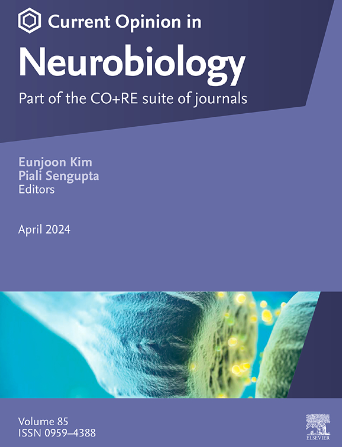Central regulation of cardio-behavioral responses: Circuit engagement during aversive emotional states
IF 5.2
2区 医学
Q1 NEUROSCIENCES
引用次数: 0
Abstract
Dynamic cardiovascular control supports adaptive behavior under external and internal influences. Higher-order brain regions regulate stress-related cardiovascular changes via their influence on medullary nuclei, which control autonomic reflexes. Despite extensive research, the precise neural circuits linking cardiac function and behavior under emotional stress remain unclear. This review highlights recent studies identifying specific cell types and pathways involved in cardiovascular regulation, emphasizing their dynamical role under baseline and threat conditions. Cardiovascular responses are closely tied to behavior through descending brain-to-heart command pathways and ascending interoceptive feedback. Our framework for characterizing cardio-behavioral states under threat identifies rapid-acting “microstates” and slow-changing “macrostates” reflecting context- and time-dependent threat levels. Multidimensional measurements and integrated analytical approaches are required to study neural circuits controlling cardio-behavioral states. Understanding the homeodynamic regulation of cardiac function and its behavioral links is essential for unraveling brain-heart interactions.
心脏行为反应的中枢调节:厌恶情绪状态下的回路参与
动态心血管控制支持在外部和内部影响下的适应性行为。高阶脑区通过影响髓核来调节与压力相关的心血管变化,髓核控制自主神经反射。尽管进行了广泛的研究,但在情绪压力下连接心脏功能和行为的精确神经回路仍不清楚。这篇综述重点介绍了最近的研究,确定了参与心血管调节的特定细胞类型和途径,强调了它们在基线和威胁条件下的动态作用。通过下行的脑-心命令通路和上行的内感受反馈,心血管反应与行为密切相关。我们描述威胁下心脏行为状态的框架确定了快速作用的“微观状态”和缓慢变化的“宏观状态”,反映了环境和时间依赖的威胁水平。研究控制心脏行为状态的神经回路需要多维测量和综合分析方法。了解心脏功能的动态调节及其行为联系对于揭示脑-心相互作用至关重要。
本文章由计算机程序翻译,如有差异,请以英文原文为准。
求助全文
约1分钟内获得全文
求助全文
来源期刊

Current Opinion in Neurobiology
医学-神经科学
CiteScore
11.10
自引率
1.80%
发文量
130
审稿时长
4-8 weeks
期刊介绍:
Current Opinion in Neurobiology publishes short annotated reviews by leading experts on recent developments in the field of neurobiology. These experts write short reviews describing recent discoveries in this field (in the past 2-5 years), as well as highlighting select individual papers of particular significance.
The journal is thus an important resource allowing researchers and educators to quickly gain an overview and rich understanding of complex and current issues in the field of Neurobiology. The journal takes a unique and valuable approach in focusing each special issue around a topic of scientific and/or societal interest, and then bringing together leading international experts studying that topic, embracing diverse methodologies and perspectives.
Journal Content: The journal consists of 6 issues per year, covering 8 recurring topics every other year in the following categories:
-Neurobiology of Disease-
Neurobiology of Behavior-
Cellular Neuroscience-
Systems Neuroscience-
Developmental Neuroscience-
Neurobiology of Learning and Plasticity-
Molecular Neuroscience-
Computational Neuroscience
 求助内容:
求助内容: 应助结果提醒方式:
应助结果提醒方式:


